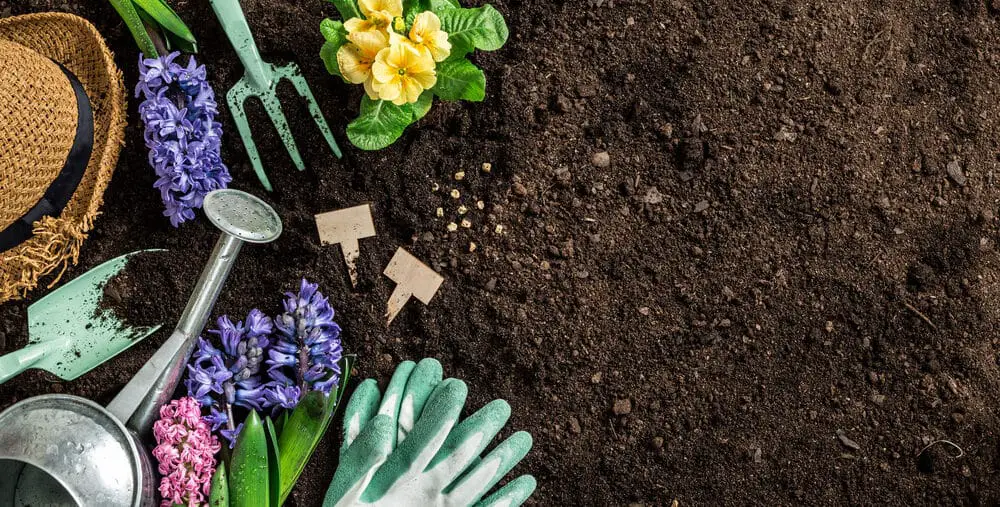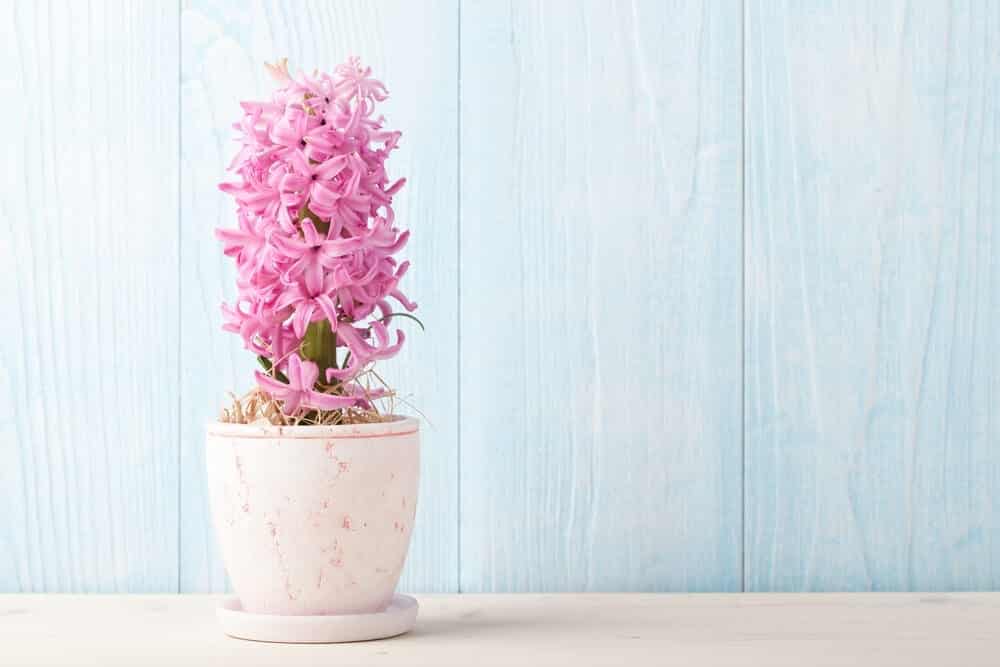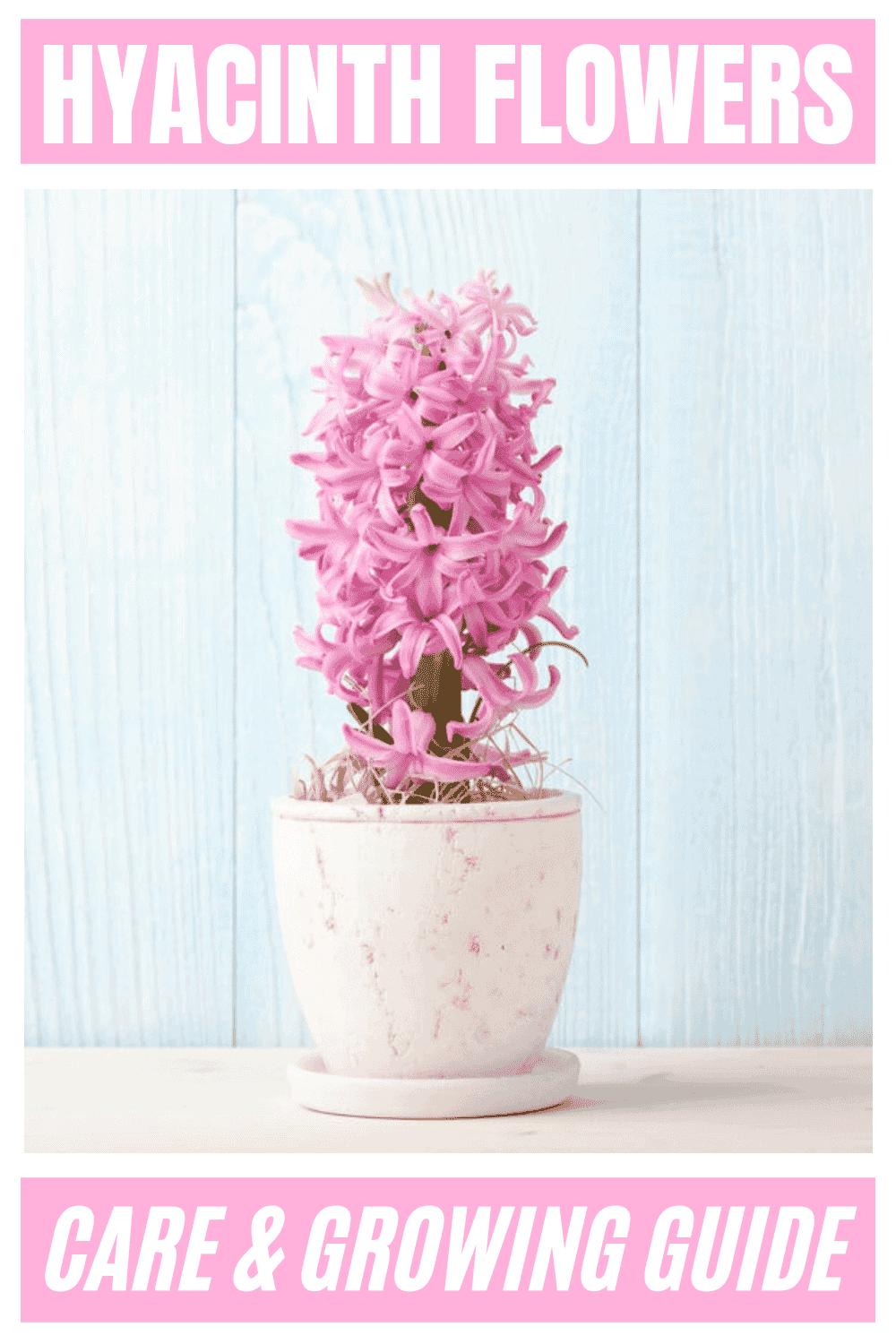Hyacinth flowers are known for their gorgeous coloring and long, full bloom.
They’re mostly planted in the spring, and the color of its flowers range from a vibrant pink to a soft white and a striped blue.
Hyacinth Flowers Care & Growing Guide
1. Light Requirement
This plant needs to be in full sun because of its large bloom of flowers. It can handle indirect light and partial shade too, but its bloom will not be as vibrant. If they’re not receiving enough, the stems will grow leggy, and it will have a significant lack of flowers during springtime.
2. Water
If you are planting the flowers into the ground, make sure to water them after they are planted. They can be watered during the winter, but scarcely and the ground has to dry out between winter waterings. During all other seasons, keep the ground damp but not soaked.
3. Climate and Temperature
Although it’s bloom will not last throughout the year, this plant can handle winter. The hardiness zones it does best in is from 3 to 9. The colder the winter, is the more protection it will need. In fact, in order to bloom, this plant needs to experience a frost, so it won’t do well in spaces where the weather is hot and humid throughout the year.
If you do live in an area that is hot, but you still want to plant hyacinth flowers, the plants will need to be placed in a fridge to chill, and then they can be brought out during the spring to bloom.
If you can keep these plants cool Bring It season of its bloom, the bloom will last longer. It does best in temperatures from 45F to 65F.
4. Soil
The soil that is best for the Hyacinth plant is more on the acidic side but not too much. It likes to soil to be down but never soak it. Make sure the soil is well-drained. It doesn’t have to be fertilized often, because too much fertilizer can ruin the structure of the stem.

5. Repotting
To prep the Hyacinthus plant so it can be repotted, first trim off all dead leaves and stems. Then softly remove the plant from its container. Gently shake off excess soil and expose the roots a bit. Transfer it to a bigger container filled with soil that drains well. You can place rocks at the bottom of the pot in order to improve drainage. Once repotting is done water, water it enough so that it comes out of the drainage holes at the bottom.
6. Speed of Growth
If you are planting them from seeds, it usually takes about one year for this plant to grow and flower. Since it has so many flowers to bloom, it can take as long as four months for the bulbs to form properly.
7. Height and Spread
Because most of this plant’s energy is dedicated to blooming flowers, it does not grow very tall. When it reaches maturity, the hyacinth flower can grow around 6 to 12 in height and around 9 in width.
8. Trimming and Harvesting Flowers
Only trim this plant when the blooming season is done, usually in the late spring. To begin, cut off the flower stalks but allow the rest of the plant to keep their leaves. They need to absorb the sun’s rays in order to build energy for next year’s bloom. As always, cut off any decayed or diseased matter.
If you are harvesting the flowers to sell or to put in vases, you can harvest in two ways. They can be cut from the base of the plant’s stem, or you can cut them all the way down to the root. If you cut them from the stem, they will not last as long. If you cut them from the root, there will be extra foliage and roots to take care of, but the flower will last much longer.

Is the Hyacinth Flowers Poisonous?
Although Hyacinth glowers are not poisonous to humans, they are poisonous to our pets. If our pets were to ingest a leaf or flower, they would have respiratory issues and stomach problems. The poison comes from calcium oxalate, which is found throughout the plant. It is not a good plan to have this plant when you have pets for young children.
If you touch a flower or bulb for too long, and humans could develop an itch or rash on the skin. Be sure to wear gloves when touching this plant.
Can Hyacinth Flowers Grow in Water?
No, this plant cannot grow in water. It does not like the ground to be soaked and will not root in wet soil. Plus, it can face many diseases because of wet soil around its roots.
Do the Hyacinth Flowers have flowers, and how do I get them to bloom?
Yes. Hyacinth flowers bloom once in the year in the spring. But that is only in their first year. In the next years of their life, they bloom throughout the year, whenever conditions are for blooming are met.
To improve the chances of blooming, and the bounty of flowers, make sure to keep these flowers soil damp. The sun shouldn’t be too strong or winter too cold. If you have indoor plants, place them in the fridge for six weeks and then bring them out when spring begins to warm up the air.
Common Diseases
Black spot is a common fungus that affects flowering plants. The spots are on the upper leaves and are about half an inch. It causes the leaves to turn yellow and fall off. It happens when the plant is wet, and the air is cold. To fight it, trim off all infected foliage and apply neem oil or another mild fungicide to the whole plant
Yellow rot turns leaves yellow and then brown. It kills the stem as well. You’ll notice you have yellow rock when you see a yellow slime on stem and leaves. There’s no cure for yellow rot; you must dig out the affected plants and throw them away.
Keep reading:
- Calla Lily Flowers Care & Growing Guide
- Sunflowers Care & Growing Guide
- Queen Of The Night Flower [Plant Care Guide]
Conclusion
- This plant grows up to a foot in height.
- It will not bloom if there is too much fertilizer in the soil
- The ground around it should be damp.
- It does best in full direct sunlight.
- You have to chill the plant for several weeks in order for them to bloom in hot areas.

Victoria is the owner and main author of hobby plants. She loves spending her free time in her garden planting and taking care of her plants. Victoria hopes you enjoy the content here!
![Queen Of The Night Flower [Complete Plant Care Guide] Queen Of The Night Flower [Complete Plant Care Guide]](https://www.hobbyplants.com/wp-content/uploads/2022/07/queen-of-the-night-flower-300x158.jpg)
![Mother Of Thousands Plant [Complete Plant Care Guide] Mother Of Thousands Plant [Complete Plant Care Guide]](https://www.hobbyplants.com/wp-content/uploads/2022/07/mother-of-thousands-plant-300x158.jpg)
![How Often Should You Water Pothos? [Complete Care Guide] How Often Should You Water Pothos? [Complete Care Guide]](https://www.hobbyplants.com/wp-content/uploads/2022/07/how-often-to-water-pothos-300x158.jpg)
![Can Snake Plants Live Outside? [COMPLETE CARE GUIDE] Can Snake Plants Live Outside? [COMPLETE CARE GUIDE]](https://www.hobbyplants.com/wp-content/uploads/2022/08/can-snake-plants-live-outside-300x158.jpg)
![Majesty Palm Plant Care: [Complete Beginner's Guide] Majesty Palm Plant Care: [Complete Beginner's Guide]](https://www.hobbyplants.com/wp-content/uploads/2022/08/majesty-palm-care-300x158.jpg)
![Exotic Angel Plant Care: [Complete Beginner's Guide] Exotic Angel Plant Care: [Complete Beginner's Guide]](https://www.hobbyplants.com/wp-content/uploads/2022/08/exotic-angel-plant-care-300x158.jpg)
![Do Coleus Like Sun Or Shade: [Complete Care Guide] Do Coleus Like Sun Or Shade: [Complete Care Guide]](https://www.hobbyplants.com/wp-content/uploads/2022/08/coleus-sun-or-shade-300x158.jpg)
![Snow White Waffle Plant: [Complete Care Guide] Snow White Waffle Plant: [Complete Care Guide]](https://www.hobbyplants.com/wp-content/uploads/2022/08/snow-white-waffle-plant-300x158.jpg)
![Waffle Plant Care: [Complete Beginner's Guide] Waffle Plant Care: [Complete Beginner's Guide]](https://www.hobbyplants.com/wp-content/uploads/2022/08/waffle-plant-300x158.jpg)
![Bird Of Paradise Plant Care: [Complete Beginner's Guide] Bird Of Paradise Plant Care: [Complete Beginner's Guide]](https://www.hobbyplants.com/wp-content/uploads/2022/08/bird-of-paradise-plant-300x158.jpg)
![Purple Passion Plant Care: [Complete Beginner's Guide] Purple Passion Plant Care: [Complete Beginner's Guide]](https://www.hobbyplants.com/wp-content/uploads/2022/08/purple-passion-plant-care-300x158.jpg)
![China Doll Plant Care: [Complete Beginner's Guide] China Doll Plant Care: [Complete Beginner's Guide]](https://www.hobbyplants.com/wp-content/uploads/2022/09/china-doll-plant-care-300x158.jpg)